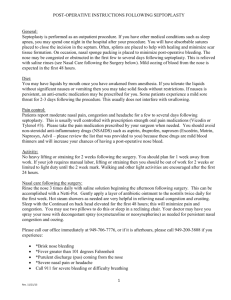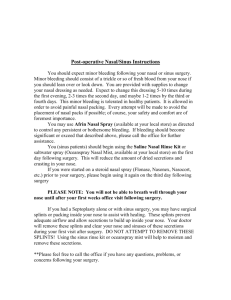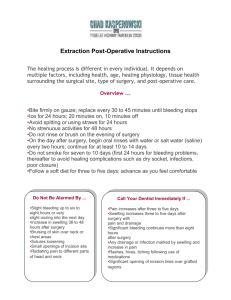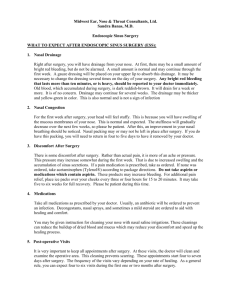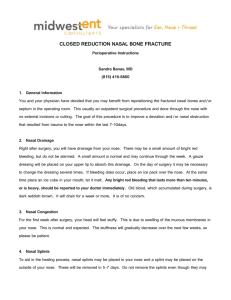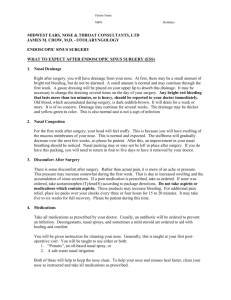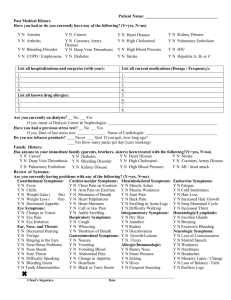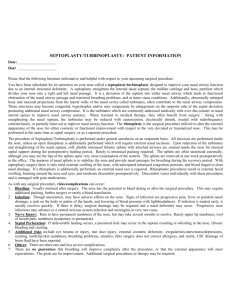SEPTOPLASTYSURGERY
advertisement
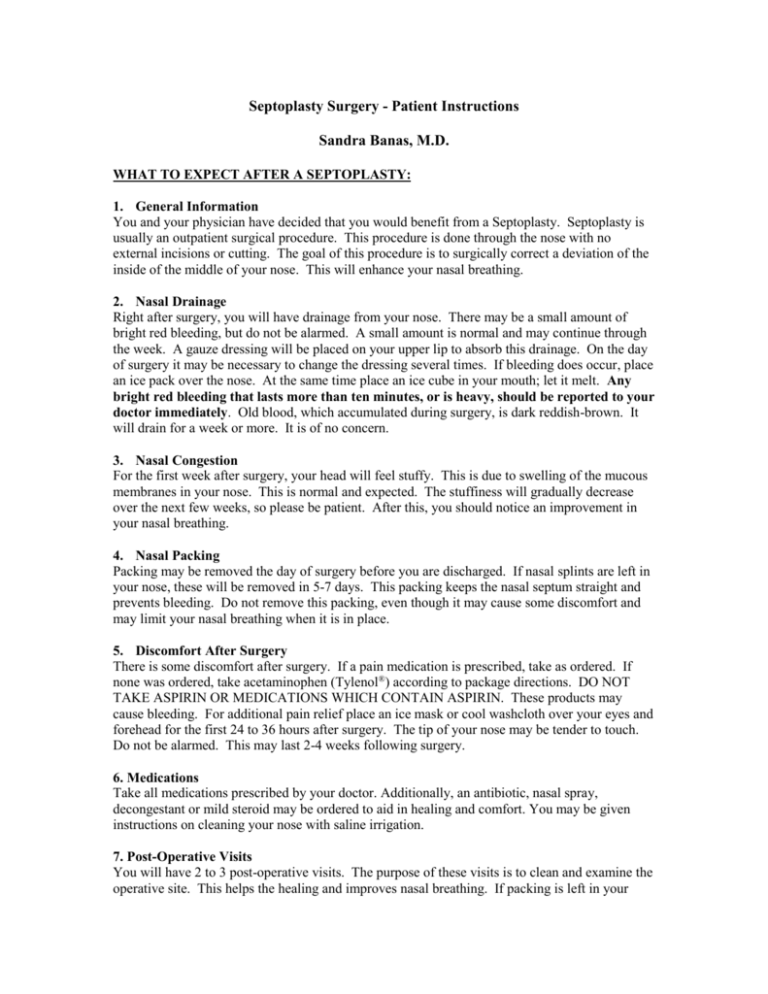
Septoplasty Surgery - Patient Instructions Sandra Banas, M.D. WHAT TO EXPECT AFTER A SEPTOPLASTY: 1. General Information You and your physician have decided that you would benefit from a Septoplasty. Septoplasty is usually an outpatient surgical procedure. This procedure is done through the nose with no external incisions or cutting. The goal of this procedure is to surgically correct a deviation of the inside of the middle of your nose. This will enhance your nasal breathing. 2. Nasal Drainage Right after surgery, you will have drainage from your nose. There may be a small amount of bright red bleeding, but do not be alarmed. A small amount is normal and may continue through the week. A gauze dressing will be placed on your upper lip to absorb this drainage. On the day of surgery it may be necessary to change the dressing several times. If bleeding does occur, place an ice pack over the nose. At the same time place an ice cube in your mouth; let it melt. Any bright red bleeding that lasts more than ten minutes, or is heavy, should be reported to your doctor immediately. Old blood, which accumulated during surgery, is dark reddish-brown. It will drain for a week or more. It is of no concern. 3. Nasal Congestion For the first week after surgery, your head will feel stuffy. This is due to swelling of the mucous membranes in your nose. This is normal and expected. The stuffiness will gradually decrease over the next few weeks, so please be patient. After this, you should notice an improvement in your nasal breathing. 4. Nasal Packing Packing may be removed the day of surgery before you are discharged. If nasal splints are left in your nose, these will be removed in 5-7 days. This packing keeps the nasal septum straight and prevents bleeding. Do not remove this packing, even though it may cause some discomfort and may limit your nasal breathing when it is in place. 5. Discomfort After Surgery There is some discomfort after surgery. If a pain medication is prescribed, take as ordered. If none was ordered, take acetaminophen (Tylenol®) according to package directions. DO NOT TAKE ASPIRIN OR MEDICATIONS WHICH CONTAIN ASPIRIN. These products may cause bleeding. For additional pain relief place an ice mask or cool washcloth over your eyes and forehead for the first 24 to 36 hours after surgery. The tip of your nose may be tender to touch. Do not be alarmed. This may last 2-4 weeks following surgery. 6. Medications Take all medications prescribed by your doctor. Additionally, an antibiotic, nasal spray, decongestant or mild steroid may be ordered to aid in healing and comfort. You may be given instructions on cleaning your nose with saline irrigation. 7. Post-Operative Visits You will have 2 to 3 post-operative visits. The purpose of these visits is to clean and examine the operative site. This helps the healing and improves nasal breathing. If packing is left in your nose, it will be removed at your first post-operative visit with minimal discomfort. If everything is healing well, your last visit will be 10 to 14 days later. General Precautions: 1. Activity Even though your surgery may seem minor, your body needs additional rest for healing. You should stay at home for one day. Observe for bleeding during that time. Call your doctor immediately if you have any bright red bleeding which lasts longer than 10 minutes or if bleeding is heavy. If the surgery is done under local anesthesia, you should gradually increase your activities over 3 to 4 days. If general anesthesia is used, increase your activities over a one week period. Most people return to work within 4 to 5 days after surgery. 2. Do Not Blow Your Nose It is important that you do not blow your nose. Blowing the nose may cause bleeding. You may gently blow your nose one week after your nasal packing is removed. 3. Sneezing If you must sneeze, do so with your mouth open. Sneezing through your mouth reduces pressure and discomfort of the operative site. 4. Do Not Lift Heavy Objects Avoid bending over and lifting heavy objects (over 5 pounds) during the first two weeks after surgery. These activities place pressure on the operative site and may cause bleeding. SUGGESTIONS FOR COMFORT 1. When resting, keep your head elevated on two to three pillows. This position will help you feel more comfortable because it helps to decrease swelling. It also allows for better drainage of nasal discharge. 2. Use a cool vapor humidifier at your bedside the first week after surgery. This will help loosen secretions and prevent crusting. 3. Three times a day, place a “fingertip” of Bacitracin® ointment along the incision in the left nostril. This will help prevent infection. If you have any questions or concerns, please call our office at 815-416-6800 Monday through Friday, 9:00 a.m. to 5:00 p.m. I understand the above instructions and accept responsibility for compliance. I have no further questions. _______________________________________ __________________ Signature of Patient/Responsible Party & Relationship Date _______________________________________ __________________ Signature of RN/MD Department Date Patient is non-English speaking; instructions given through interpreter.
